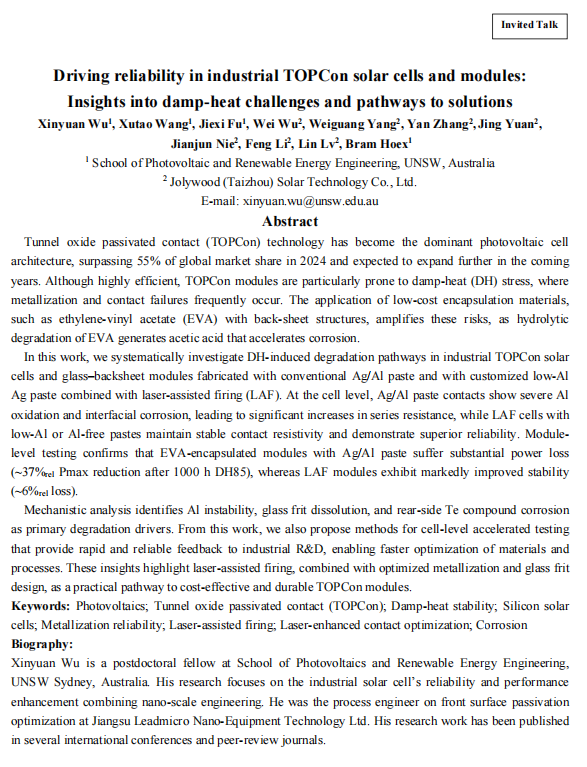| Driving reliability in industrial TOPCon solar cells and modules: Insights into damp-heat challenges and pathways to solutions【Xinyuan Wu】 |
| 发布时间:2025-10-14 | 浏览次数:143 |
Insights into damp-heat challenges and pathways to solutions Xinyuan Wu1, Xutao Wang1, Jiexi Fu1, Wei Wu2, Weiguang Yang2, Yan Zhang2, Jing Yuan2, Jianjun Nie2, Feng Li2, Lin Lv2, Bram Hoex1 1 School of Photovoltaic and Renewable Energy Engineering, UNSW, Australia 2 Jolywood (Taizhou) Solar Technology Co., Ltd. E-mail: xinyuan.wu@unsw.edu.au Abstract Tunnel oxide passivated contact (TOPCon) technology has become the dominant photovoltaic cell architecture, surpassing 55% of global market share in 2024 and expected to expand further in the coming years. Although highly efficient, TOPCon modules are particularly prone to damp-heat (DH) stress, where metallization and contact failures frequently occur. The application of low-cost encapsulation materials, such as ethylene-vinyl acetate (EVA) with back-sheet structures, amplifies these risks, as hydrolytic degradation of EVA generates acetic acid that accelerates corrosion. In this work, we systematically investigate DH-induced degradation pathways in industrial TOPCon solar cells and glass–backsheet modules fabricated with conventional Ag/Al paste and with customized low-Al Ag paste combined with laser-assisted firing (LAF). At the cell level, Ag/Al paste contacts show severe Al oxidation and interfacial corrosion, leading to significant increases in series resistance, while LAF cells with low-Al or Al-free pastes maintain stable contact resistivity and demonstrate superior reliability. Module-level testing confirms that EVA-encapsulated modules with Ag/Al paste suffer substantial power loss (~37%rel Pmax reduction after 1000 h DH85), whereas LAF modules exhibit markedly improved stability (~6%rel loss). Mechanistic analysis identifies Al instability, glass frit dissolution, and rear-side Te compound corrosion as primary degradation drivers. From this work, we also propose methods for cell-level accelerated testing that provide rapid and reliable feedback to industrial R&D, enabling faster optimization of materials and processes. These insights highlight laser-assisted firing, combined with optimized metallization and glass frit design, as a practical pathway to cost-effective and durable TOPCon modules. Keywords: Photovoltaics; Tunnel oxide passivated contact (TOPCon); Damp-heat stability; Silicon solar cells; Metallization reliability; Laser-assisted firing; Laser-enhanced contact optimization; Corrosion Biography: Xinyuan Wu is a postdoctoral fellow at School of Photovoltaics and Renewable Energy Engineering, UNSW Sydney, Australia. His research focuses on the industrial solar cell’s reliability and performance enhancement combining nano-scale engineering. He was the process engineer on front surface passivation optimization at Jiangsu Leadmicro Nano-Equipment Technology Ltd. His research work has been published in several international conferences and peer-review journals.
|






